Government Briefs 04.28.16
Government Briefs 04.28.16
East Hampton Town
Planning a Paumanok Campsite
A rough campsite for hikers along the Paumanok Path could be created near a section of the trail in Montauk close to the Navy Road park property, allowing hikers traversing the path, which runs 125 miles from Rocky Point to Montauk Point, to do an extended portion without leaving the woods.
A small area would be cleared just off the trail, should East Hampton Town officials sign off on the idea, brought to them recently by Andrew Drake of the town’s office of land acquisition and management. The Paumanok Path is a “designated long-distance scenic path,” Mr. Drake said. The East Hampton Trails Preservation Society and other hiking groups are seeking a national designation of the trail’s importance, he said.
The land department staff, which already maintains other trails in Montauk, would mow a 100-foot spur to the camping spot off the main trail and issue the permits that would be required to stay there overnight. Campers — up to six people using no more than two tents — would be limited to a one-night stay.
Although town board members expressed concern about the potential for abuse of the site, “I’m willing to try this,” Supervisor Larry Cantwell said at a recent meeting. “If it gets out of hand we can shut it down.”
Classes for Contractors
Continuing education classes that will help those with East Hampton Town contractor’s licenses meet licensing requirements will be offered by the town in conjunction with the East End Council of the Long Island Business Institute beginning on Wednesday with a session on the 2016 state energy conservation construction code, which goes into effect at the end of September. Sessions will continue on May 25, with “Best Practices to Meet and Exceed the New York State Energy Construction Code,” followed by “Marketing for Contractors” on June 15, and a session on “next generation” flooring on June 29. The classes will be held at 3 p.m. at Town Hall.
The cost for each session is $25 for Long Island Business Institute members and $40 for nonmembers. Those interested can register by calling the institute; limited registration at the door may be possible, depending on space.
Eyeing One-Ways for Montauk
A number of streets in downtown Montauk could be designated one-way thoroughfares, should the East Hampton Town Board act on recommendations recently presented by a traffic engineer hired to come up with ways to ease traffic and parking issues in the hamlet.
Ray DiBiase of McLean Associates gave an overview of his ideas at an April 12 board meeting. They include limiting Elwood Avenue, just south of Montauk Highway in downtown Montauk, to one way, headed east, and limiting all of Emerson Avenue, between Eton Street on the west to Edison Street on the east, to westbound-only traffic. The plan would also eliminate right turns from the highway onto Eton and Eagle Streets at the hamlet’s western edge.
Layout plans depicting the proposed changes, which include adding parking spaces and a taxi stand and moving the crosswalk across Main Street from the west side of the Plaza to its eastern side, are posted on the town’s website.
Reconsidering Beach Generators
Areas along the Montauk ocean beach adjacent to the sites where the town leases spots for food trucks to sell their wares could be quieter, and with cleaner air, this summer, if an agreement is inked between the town and a company that would provide electricity to the sites, eliminating the need for the trucks to use noisy generators that emit exhaust for power.
Councilman Peter Van Scoyoc announced recently that the company was interested in installing pedestal kiosks providing electrical service, for which the concessionaires would pay. The town would receive 20 percent of the charges as revenue, he said. The pilot program could eliminate noise and fumes from the lots at Kirk Park and at Ditch Plain, both in the main lot and at the dirt lot near the former East Deck motel.
A Lazy Point C.P.F. Purchase
The town board approved the purchase of .22 of an acre at 60 and 66 Shore Drive East at Lazy Point, now owned by Paul Capocciamo, Colette Gambino, Lorraine Ericson, and Mary Capocciamo, for $915,000 following a public hearing last Thursday. A small house on the property will be removed at the seller’s expense before the purchase. The money will come from the community preservation fund. The property, in a low-lying shorefront area, will be returned to its natural state but could be used in the future to provide public parking for water access, Supervisor Larry Cantwell said.
Booking App Owes Airport $35K
Blade, a service through which flights between Manhattan and East Hampton Airport can be booked using an app, or charter flights organized through a crowdsourcing system, owes East Hampton Town $35,000 for activities at the airport last summer, and is seeking a three-year seasonal license to continue doing business there.
Councilwoman Kathee Burke-Gonzalez, the board’s airport liaison, said at a meeting last week that Blade, which was doing business at the airport last summer, was told it must pay rent to the town to continue to operate from the airport terminal. Upon approval of a license agreement, the company will pay what is owed, followed by a $37,500 fee for the next May 1 to Sept. 30 season, and $40,000 for the third year. The town will reserve the right to cancel the license agreement at any time. J.P.
Federal Vote to Prevent Plum Island Sale
Representative Lee Zeldin on Sunday announced that a bill that would prevent the sale of Plum Island is scheduled to be voted on today in the House Homeland Security Committee, paving the way for a full House vote later this year. The bill would require the Government Accountability Office and the Department of Homeland Security, which owns the island, to develop a plan for other uses for it. It is home to the Plum Island Animal Disease Center.
According to a release, Mr. Zeldin’s bill outlines a future for Plum Island that could include a transfer to another federal agency, New York State, or a nonprofit organization. An educational or conservation opportunity is another possibility. Under current law, the disease center is to be decommissioned and the island is to be cleaned up and sold to the highest bidder, a plan that is opposed by many local and state officials and civic leaders.



